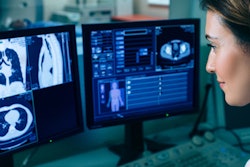
Whether individuals undergo CT lung cancer screening can depend not only on social factors such as unreliable transportation and type of insurance but also on a lack of awareness of screening recommendations, according to research presented Thursday at the virtual RSNA 2020 meeting.
A Boston-based team and a group from New York City shared results from studies that explored reasons why patients eligible for lung cancer screening may not follow through and urged session attendees to apply their results to targeted interventions to boost compliance.
Social stressors
The American Cancer Society estimates that more than 234,000 new cases of lung cancer are diagnosed each year and that more than 154,000 patients die from the disease annually.
Guidelines issued in 2013 from the U.S. Preventive Services Task Force (USPSTF) recommend annual lung cancer screening with low-dose CT (LDCT) for adults between the ages of 55 and 80 who have a 30 pack-year smoking history and currently smoke or have quit within the past 15 years. (This guidance is under review and may change to adults between the ages of 50 and 80 with a 20 pack-year smoking history and current smoker or have quit within the past 15 years.)
But uptake of CT lung cancer screening is low: In fact, a report released in November by the American Lung Association (ALA) found that less than 6% of people who are eligible for lung cancer screening undergo it.
Why? A group led by Dr. Donghoon Shin of Boston Medical Center explored the question by investigating whether there are links between missed CT lung cancer screening appointments and social factors such as insurance type, housing, food, medication, transportation access, employment, difficulty arranging child or elder care in order to attend the appointment, and difficulty paying for utilities.
The study included 4,755 appointments for CT lung cancer screening for 2,801 individuals scheduled between January 2015 and December 2018. The researchers tracked missed versus completed appointments using data from the hospital's radiology information system and noted any social factors affecting patients.
Over the four-year study period, 33% of the appointments were canceled, and 41% of individuals missed at least one lung cancer screening appointment, Shin said. He and his colleagues found that insurance type (Medicare, Medicaid, private) and housing insecurity were statistically significant factors that contributed to missed appointments (p < 0.0001 and 0.014, respectively), although the housing association disappeared when the results were adjusted for insurance type.
Transportation challenges significantly influenced whether patients missed appointments: The odds of missing the lung screening appointment was 47.5% higher in patients with unreliable transportation options compared with those with stable options (p = 0.045).
Shin's group also found that the odds of missing a CT lung cancer screening appointment was almost six times higher in Medicaid patients compared with those with private insurance and four times higher compared with Medicare patients (both p < 0.0001). The investigators did not find any significant difference in missed appointments between Medicare and privately insured patients.
"We hope to apply these findings to targeted interventions to help improve ... utilization [of lung cancer screening]," Shin concluded.
Leveraging mammography for lung cancer screening
In a study presented during the same session, a team led by Dr. Eitan Novogrodsky of Montefiore Medical Center in the Bronx, New York City, investigated another reason for low lung cancer screening compliance: a lack of awareness about it.
Hypothesizing that screening mammography might present an opportunity to invite eligible women to screen for lung cancer, the group examined women's knowledge of the test and their interest in it.
The team distributed a single-page survey to all screening mammography patients at six sites on the East and West coasts between January and March 2020. The survey included questions about smoking history, awareness of lung cancer screening and compliance, and interest in screening.
The group received 1,965 responses; of these, 539 (27%) had a history of smoking. Of those with a smoking history, 30 (5.6%) met USPSTF 2013 lung cancer screening criteria and 52 (9.7%) would be eligible according to the proposed 2020 criteria, Novogrodsky said.
Only 12.9% of all the survey respondents had ever heard of lung cancer screening. Eighty percent of those currently eligible expressed an interest in it, but only 30% had undergone it, Novogrodsky said.
He acknowledged that one of the study's limitations is that screening mammography volume has been negatively affected by the COVID-19 pandemic. But the overall takeaway -- that screening mammography can be leveraged to educate women about lung cancer screening -- still stands, Novogrodsky concluded.
"Both the general population and eligible patients have limited awareness of lung cancer screening, but the majority of eligible patients are interested in it," he said. "The screening mammography population may benefit from a targeted effort to expand participation in lung cancer screening in accordance with USPSTF guidelines."





















